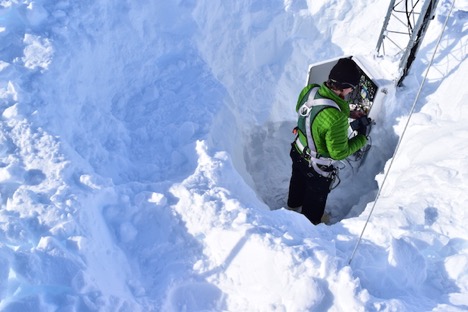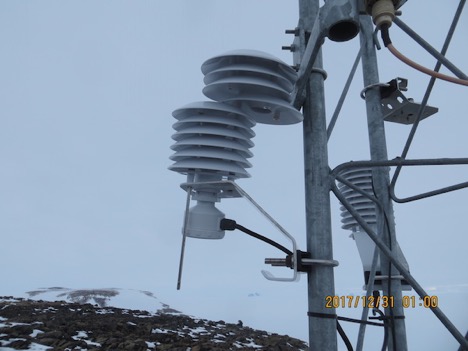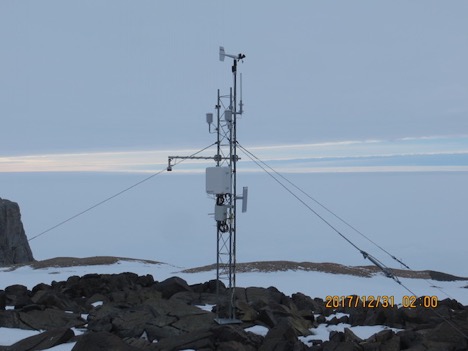It has been a while since I’ve written a post, and that’s with good reason. Marian and I have been very productive in the past week and a half, flying to 4 of our 7 Otter sites and completing the work at Kominko-Slade, the AWS near WAIS camp. We went on a stretch of 4 straight days of work on 3 AWS, and 4 AWS completed in 5 days, and 5 AWS in 7 days. That’s a pretty darn good ratio of AWS per work days! Given that, I haven’t had much time to write up a blog post. Now it’s Sunday, 07 Jan, so I have some time to get some updates written down. I’ll split up the posts here to make things a little bit more palatable, rather than cramming everything into one long post.
Here’s a list of the sites we’ve serviced thus far:
29 Dec: Kathie
31 Dec: Bear Peninsula
02 Jan: Harry
03 Jan: Austin
04 and 05 Jan: Kominko-Slade
This post will cover our work at Kathie and Bear Peninsula.
On 29 December, Marian and I visited our first site out of WAIS, Kathie AWS. We were ecstatic to get to this site only two days after getting to camp, especially since it was 2nd highest on our priority list. Back in January 2016, this site was installed by Lee and Carol. This is the first time we’ve revisited it, so we were very curious to see how the AWS was holding up, especially since our acoustic depth gauge (ADG) measurements indicated that there was a fair amount of snow accumulation. We were certain we were going to need to raise it with another tower section as the ADG measurements implied a lot of digging was needed. As shown in the picture below, the power system and the electronics enclosure were buried.
After we got heights of the instruments, we began digging out the buried instrumentation. When the cables on the tower were free enough with slack, I could begin removing some of the instruments while Marian continued digging. When she dug far enough to expose the enclosure, I went down to remove the data card from the datalogger and power down the station.

Me in the pit. I’m standing on the battery box, so we had to dig about an additional 2 feet to free it. That made it a pit about 8 feet deep.
Once I removed the upper instrumentation (aerovane, upper temperature sensor), Marian and I climbed up the tower to start installing the new tower section. To put it bluntly, we had a devil of a time getting the tower section on and spent about an hour trying to do so. We brought two 7-foot sections in case one gave us trouble. As it turned out, one new tower fit slightly better than the other, but one of the poles on the existing tower was bowed out about a quarter of an inch. To solve this issue, we tried hitting it in with a sledge hammer (probably over 200 times). This got the pole to within about 1/16 of an inch of fitting, but the new tower still wouldn’t slide on. We were getting exhausted. Then Brandon had a brilliant idea: use a small cargo strap to tie around the old tower, then tighten it to synch the poles together. We tried this, and the new tower slid on after only a few cranks on the cargo strap. What a relief! Marian and I could finally start reinstalling the instrumentation on the tower.
On New Year’s Eve, Marian and I flew to Bear Peninsula. We had plenty of extra room on the plane, so we brought along two camp staff, Brian (heavy equipment operator) and Gus (weather observer). Bear Peninsula had not been visited since it was installed in November 2011. According to the data we’ve been receiving from it, it has been running smoothly for those 6 years. Of course, there are issues that the data alone can’t reveal, so it was very valuable to get to the site (if not to fix the issues, then to at least get more pictures of the site!).
Near our site, there is a bluff that a lot of snow petrels (big white birds) call home. We flew by the bluff, and I could see several of the birds flying around. Unfortunately, I couldn’t get a good picture of the birds themselves.
After we landed on the peninsula, in a snow field, we had about a 10 minute hike up to our AWS. It was icy up the hill until we reached the rocky area where our site is located.

The hike (on our way back actually), with the beginning of the rocky ground in the foreground and the icy hill just beyond it. Luckily there was about an inch of snow on the ice which provided enough grip for us to make it much less treacherous.
Bear Peninsula gets some pretty high winds at times. It’s impressive that the aerovane at the top of the tower hadn’t broken off. It was still reporting wind speed and direction, but upon further inspection, the aerovane doesn’t turn properly. This means the direction values are incorrect. This also affects wind speed values because the instrument has a difficult time turning into the wind to get good values when the wind speed is too low. On our next visit, we will need to replace this instrument.
The Gill radiation shields for the temperature and relative humidity sensors needed some fixing as well. Each shield has 3 long screw rods to hold the multiple plates together. Each shield, however, was missing a rod and one was loose. I tightened those and prevented any further damage as best as I could.
Another issue we found was that one of the three guy wires was getting worn down by a large rock near it. The guy wire isn’t rubbing against the rock on its own, but in high winds it wobbles enough to rub against the rock. It’s been worn fairly thin at that point, so we used a cargo strap to temporarily hold the guy wire in place, in case the guy wire breaks before we can replace it on our next visit.
Overall, the site visit went well. Hopefully things don’t get too damaged until we can visit it again, which will hopefully only be in a year.
Cheers,
Dave Mikolajczyk













